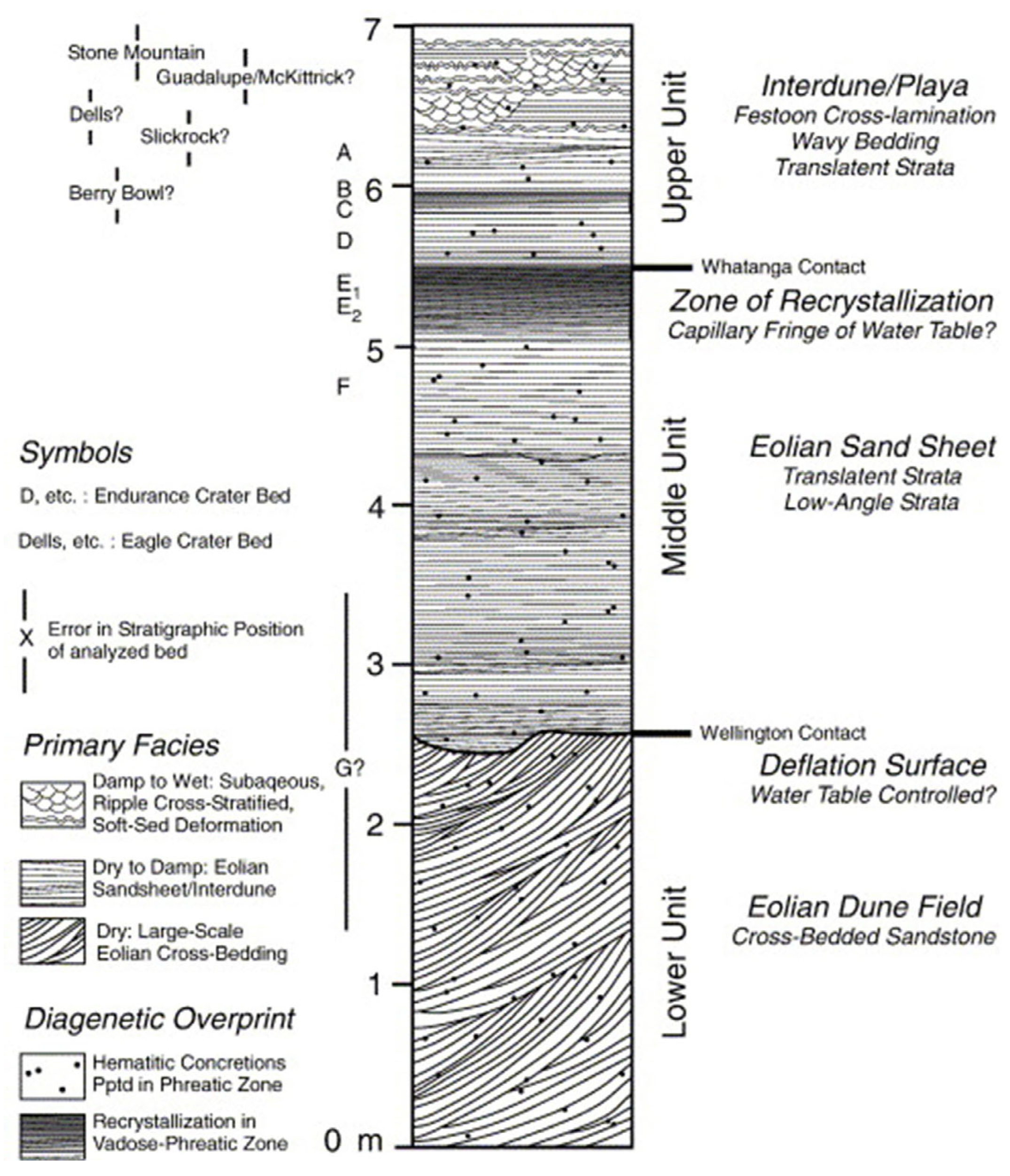Meridiani Planum Mineralogy Along Part of the Opportunity Rover Track Based on the Mini-TES Spectrum
Abstract
1. Introduction
1.1. Research Objectives
- (1)
- The general goal is to use the spectral data from the Mini-TES to investigate the local mineralogy, petrology, and other features of the regolith (or outcrops) along a selected part of the rover’s path.
- (2)
- The important objects of research are the commonly occurring spherules (known as blueberries) on the route. They are related, among other things, to our research on the origin of terrestrial and Martian spherical concretions [2].
- (3)
- To take into account the part of the spectrum in the range of the small wavenumber values, which allowed for obtaining data on minerals with characteristic spectral features in this range (including pyrite).
1.2. Opportunity Rover Mission
1.2.1. Mini-TES Overview
- Determine the mineralogy of regolith;
- Determine the thermophysical properties of the soil;
- Determine the temperature, dust, and water vapor abundance in the lower atmosphere.
1.2.2. Tests and Calibrations
- The emissivity and effective temperature of the internal reference surface;
- The instrument response function and its variation with the instrument temperature;
- The absolute radiometric accuracy;
- The spectrometer noise characteristics;
- The spectrometer gain values.
1.3. Meridiani Planum—General Data
1.4. Basic Information About the Regolith Along the Rover’s Route
2. Methods
2.1. Procedures and Methods
- (1)
- A determination of the measured object.
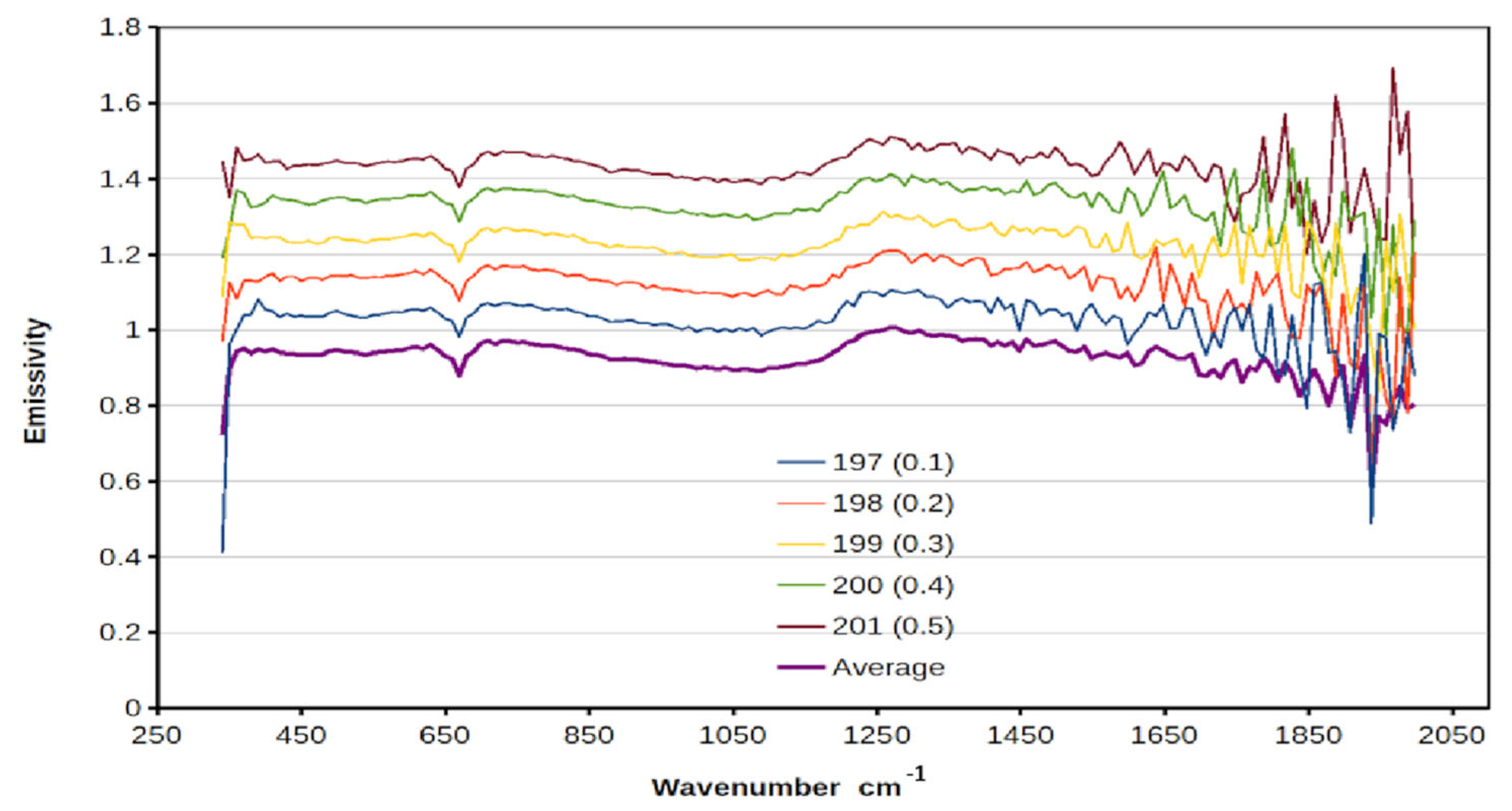


- (2)
- The selection of measurements.
- (3)
- The selection of the spectral range.
- (4)
- The selection of minerals and library spectra (See Section 3.1.1 for this problem).
- (5)
- The performance of numerical calculations.
- 5.1. The generation of an initial random solution;
- 5.2. The least squares method is used for improving the solutions;
- 5.3. A selection of the best solution;
- 5.4. If a solution is not acceptable, go back to 5.1; otherwise, start a discussion and interpretation of the solution.
2.2. Solution Stability
- (i)
- Relative to the initial solution approximation;
- (ii)
- In terms of the required accuracy of the solution approximation;
- (iii)
- Relative to the methods of data averaging (number or selection of averaged data);
- (iv)
- Stability against the excluded regions with the largest fluctuations (see above);
- (v)
- Stability towards different spectral libraries;
- (vi)
- Controls for removing unrealistic minerals from the solution.
3. Results
3.1. Data Emissivity
3.1.1. Selected Minerals
3.1.2. Library Spectra
3.2. Presentation of Results
4. Discussion
4.1. Mineralogy Along Rover’s Route (Figure 15)

4.1.1. Sector 1 (Containing Measurements from Sol 313a to Sol 314b, with Six Measurements in Total)
4.1.2. Sector 2 (Sols 315–331c, 19 Measurements in Total)
4.1.3. Sector 3 (Sols 382a–389b, 15 Measurements in Total)
4.1.4. Sector 4, (Sols 389c–394a, 14 Measurements)
4.1.5. Sector 5 (Sols 395a–395d, Four Measurements)
4.1.6. Sector 6 (Sols 395e–395g, Three Measurements)
4.2. General Processes Along the Route
Correlations
4.3. Problems of Hematite and Spherical Concretions
4.4. Problems of Pyrite and Quartz
4.5. Comparison with Mossbauer and APXS Results
4.6. The Importance of Research—Discussion
5. Conclusions
Author Contributions
Funding
Data Availability Statement
Acknowledgments
Conflicts of Interest
References
- MER Mission. Available online: https://an.rsl.wustl.edu/help/Content/About%20the%20mission/MER/MER%20mission.htm (accessed on 21 December 2024).
- Calvin, W.M.; Shoffner, J.D.; Johnson, J.R.; Knoll, A.H.; Pocock, J.M.; Squyres, S.W.; Weitz, C.M.; Arvidson, R.E.; Bell, J.F., III; Christensen, P.R.; et al. Hematite spherules at Meridiani: Results from MI, Mini-TES, and Pancam. J. Geophys. Res. Planets 2008, 113, E12S37. [Google Scholar] [CrossRef]
- Fairén, A.G.; Dohm, J.M.; Baker, V.R.; Thompson, S.D.; Mahaney, W.C.; Herkenhoff, K.E.; Rodríguez, J.A.P.; Davila, A.F.; Schulze-Makuch, D.; El Maarry, M.R.; et al. Meteorites at Meridiani Planum provide evidence for significant amounts of surface and near-surface water on early Mars. Meteorit. Planet. Sci. 2011, 46, 1832–1841. [Google Scholar] [CrossRef]
- Squyres, S.W.; Knoll, A.H.; Arvidson, R.E.; Ashley, J.W.; Bell, J.F., III; Calvin, W.M.; Christensen, P.R.; Clark, B.C.; Cohen, B.A.; Yingst, R.A.; et al. Exploration of Victoria Crater by the Mars Rover Opportunity. Science 2009, 324, 1058–1061. [Google Scholar] [CrossRef]
- Hughes, M.N.; Arvidson, R.E.; Grant, J.A.; Wilson, S.A.; Howard, A.D.; Golombek, M.P. Degradation of Endeavour Crater Based on Orbital and Rover-Based Observations in Combination with Landscape Evolution Modeling. J. Geophys. Res. Planets 2019, 124, 1472–1494. [Google Scholar] [CrossRef]
- Christensen, P.R.; Mehall, G.L.; Silverman, S.H.; Anwar, S.; Cannon, G.; Gorelick, N.; Kheen, R.; Tourville, T.; Bates, D.; Ferry, S.; et al. Miniature Thermal Emission Spectrometer for the Mars Exploration Rovers. J. Geophys. Res. Planets 2003, 108, 8064. [Google Scholar] [CrossRef]
- Miniature Thermal Emission Spectrometer (Mini-TES). Available online: https://an.rsl.wustl.edu/help/Content/About%20the%20mission/MER/Instruments/MTES.htm?tocpath=About%20the%20missions%7CMER%20(Opportunity%20and%20Spirit)%7CInstruments%7C_____10 (accessed on 29 April 2025).
- Alpha Particle X-Ray Spectrometer (APXS). Available online: https://an.rsl.wustl.edu/help/Content/About%20the%20mission/MER/Instruments/MER%20APXS.htm?tocpath=About%20the%20missions%7CMER%20(Opportunity%20and%20Spirit)%7CInstruments%7C_____2 (accessed on 29 April 2025).
- Mössbauer Spectrometer (MB). Available online: https://an.rsl.wustl.edu/help/Content/About%20the%20mission/MER/Instruments/Moessbauer%20Spectrometer.htm?tocpath=About%20the%20missions%7CMER%20(Opportunity%20and%20Spirit)%7CInstruments%7C_____9 (accessed on 29 April 2025).
- Farmer, V.C. The Infrared Spectra of Minerals; Mineralogical Society: London, UK, 1974; 539p. [Google Scholar]
- Christensen, P.R.; Bandfield, J.L.; Hamilton, V.E.; Ruff, S.W.; Kieffer, H.H.; Titus, T.N.; Malin, M.C.; Morris, R.V.; Lane, M.D.; Clark, R.L.; et al. Mars Global Surveyor Thermal Emission Spectrometer experiment: Investigation description and surface science results. J. Geophys. Res. Planets 2001, 106, 23823–23871. [Google Scholar] [CrossRef]
- Morris, R.V.; Graff, T.G. Athena instrument validation and data library development for the Mars Exploration Rover (MER) Mission. Eos Trans. AGU 2002, 83, P21C-03. [Google Scholar]
- Wray, J.J.; Dobrea, E.Z.N.; Arvidson, R.E.; Wiseman, S.M.; Squyres, S.W.; McEwen, A.S.; Mustard, J.F.; Murchie, S.L. Phyllosilicates and sulfates at Endeavour Crater, Meridiani Planum, Mars. Geophys. Res. Lett. 2009, 36, L21201. [Google Scholar] [CrossRef]
- Bibring, J.-P.; Langevin, Y.; Mustard, J.F.; Poulet, F.; Arvidson, R.; Gendrin, A.; Gondet, B.; Mangold, N.; Pinet, P.; Forget, F.; et al. Global Mineralogical and Aqueous Mars History Derived from OMEGA/Mars Express Data. Science 2006, 312, 400–404. [Google Scholar] [CrossRef]
- Hynek, B.M.; Di Achille, G. Geologic Map of Meridiani Planum, Mars (Ver. 1.1, April 2017); Scientific Investigations Map 3356; U.S. Geological Survey: Reston, VA, USA, 2017. [Google Scholar] [CrossRef]
- Watters, T.R.; Leuschen, C.J.; Campbell, B.A.; Morgan, G.A.; Cicchetti, A.; Grant, J.A.; Phillips, R.J.; Plaut, J.J. Radar sounder evidence of thick, porous sediments in Meridiani Planum and implications for ice-filled depos-its on Mars. Geophys. Res. Lett. 2017, 44, 9208–9215. [Google Scholar] [CrossRef]
- Grotzinger, J.P.; Arvidson, R.E.; Bell, J.F., III; Calvin, W.; Clark, B.C.; Fike, D.A.; Golombek, M.; Greeley, R.; Halde-mann, A.; Herkenhoff, K.E.; et al. Stratigraphy and sedimentology of a dry to wet eolian depositional system, Burns formation, Meridiani Planum. Mars Earth Planet. Sci. Lett. 2005, 240, 11–72. [Google Scholar] [CrossRef]
- Golombek, M.P.; Warner, N.H.; Ganti, V.; Lamb, M.P.; Parker, T.J.; Fergason, R.L.; Sullivan, R. Small crater modification on Meridiani Planum and implications for erosion rates and climate change on Mars. JGR Planets 2014, 119, 2522–2547. [Google Scholar] [CrossRef]
- Golombek, M.P.; Grant, J.A.; Parker, T.J.; Kass, D.M.; Crisp, J.A.; Squyres, S.W.; Haldemann, A.F.C.; Adler, M.; Lee, W.J.; Bridges, N.T.; et al. Selection of the Mars Exploration Rover landing sites. JGR Planets 2003, 108, E12. [Google Scholar] [CrossRef]
- Fergason, R.L.; Christensen, P.R.; Kieffer, H.H. High-resolution thermal inertia derived from the Thermal Emission Imaging System (THEMIS): Thermal model and applications. JGR Planets 2006, 111, E12. [Google Scholar] [CrossRef]
- Christensen, P.R.; Wyatt, M.B.; Glotch, T.D.; Rogers, A.D.; Anwar, S.; Arvidson, R.E.; Bandfield, J.L.; Blaney, D.L.; Budney, C.; Calvin, W.M.; et al. Mineralogy at Meridiani Planum from the Mini-TES Experiment on the Opportunity Rover. Science 2004, 306, 1733–1739. [Google Scholar] [CrossRef] [PubMed]
- Rogers, A.D.; Aharonson, O. Mineralogical composition of sands in Meridiani Planum determined from Mars Exploration Rover data and comparison to orbital measurements. J. Geophys. Res. Planets 2008, 113, E06S14. [Google Scholar] [CrossRef]
- Weitz, C.M.; Anderson, R.C.; Bell, J.F., III; Farrand, W.H.; Herkenhoff, K.E.; Johnson, J.R.; Jolliff, B.L.; Morris, R.V.; Squyres, S.W.; Sullivan, R.J. Soil grain analyses at Meridiani Planum, Mars. J. Geophys. Res. Planets 2006, 111, E12S04. [Google Scholar] [CrossRef]
- Available online: http://www.psrd.hawaii.edu/July12/water-inside-Mars.html (accessed on 29 April 2025).
- Hoefen, T.M.; Clark, R.N.; Bandfield, J.L.; Smith, M.D.; Pearl, J.C.; Christensen, P.R. Discovery of Olivine in the Nili Fossae Region of Mars. Science 2003, 302, 627–630. [Google Scholar] [CrossRef]
- McSween, H.Y.; Wyatt, M.B.; Gellert, R.; Bell, J.F., III; Morris, R.V.; Herkenhoff, K.E.; Crumpler, L.S.; Milam, K.A.; Stockstill, K.R.; Tornabene, L.L.; et al. Characterization and petrologic interpretation of olivine-rich basalts at Gusev Crater, Mars. J. Geophys. Res. Planets 2006, 111, E02S10. [Google Scholar] [CrossRef]
- Christensen, P.R.; Ruff, S.W. Formation of the hematite-bearing unit in Meridiani Planum: Evidence for deposition in standing water. J. Geophys. Res. Planets 2004, 109, E08003. [Google Scholar] [CrossRef]
- Liu, Y.; Ma, C. Monazite in Martian breccia meteorite NWA 7034. In Proceedings of the Eighth International Conference on Mars Polar Science and Exploration, Whitehorse, YT, Canada, 8–12 July 2014; Available online: https://www.hou.usra.edu/meetings/8thmars2014/ (accessed on 29 April 2025).
- Klingelhofer, G.; Morris, R.V.; Bernhardt, B.; Schroder, C.; Rodionov, D.S.; de Souza, P.A., Jr.; Yen, A.; Gellert, R.; Evlanov, E.N.; Zubkov, B.; et al. Jarosite and Hematite at Meridiani Planumfrom Opportunity’s Mossbauer Spectrometer. Science 2004, 306, 1740–1745. [Google Scholar] [CrossRef] [PubMed]
- Ciążela, J.; Bakala, J.; Kowalinski, M.; Plocieniak, S.; Zalewska, N.; Pieterek, B.; Mrozek, T.; Ciazela, M.; Paslawski, G.; Steslicki, M.; et al. Concept and Design of Martian Far-IR ORE Spectrometer (MIRORES). Remote Sens. 2022, 14, 2799. [Google Scholar] [CrossRef]
- Lorand, J.-P.; Hewins, R.H.; Remusat, L.; Zanda, B.; Pont, S.; Leroux, H.; Marinova, M.; Jacob, D.; Humayun, M.; Nemchin, A.; et al. Nickeliferous pyrite tracks pervasive hydrothermal alteration in Martian regolith breccia: A study in NWA 7533. Meteorit. Planet. Sci. 2015, 50, 2099–2120. Available online: https://onlinelibrary.wiley.com/doi/10.1111/maps.12565 (accessed on 29 April 2025). [CrossRef]
- McAdam, A.C.; Franz, H.B.; Sutter, B.; Archer, P.D., Jr.; Freissinet, C.; Eigenbrode, J.L.; Ming, D.W.; Atreya, S.K.; Bish, D.L.; Blake, D.F.; et al. Sulfur-bearing phases detected by evolved gas analysis of the Rocknest aeolian deposit, Gale Crater, Mars. J. Geophys. Res. Planets 2014, 119, 373–393. [Google Scholar] [CrossRef]
- Vaniman, D.T.; Bish, D.L.; Ming, D.W.; Bristow, T.F.; Morris, R.V.; Blake, D.F.; Chipera, S.J.; Morrison, S.M.; Treiman, A.H.; Rampe, E.B.; et al. Mineralogy of a Mudstone at Yellowknife Bay, Gale Crater, Mars. Science 2014, 343, 1243480. [Google Scholar] [CrossRef]
- Wong, G.M.; Franz, H.B.; Clark, J.V.; McAdam, A.C.; Lewis, J.M.T.; Millan, M.; Ming, D.W.; Gomez, F.; Eigenbrode, J.L.; Navarro-González, R. Oxidized and Reduced Sulfur Observed by the Sample Analysis at Mars (SAM) Instrument Suite on the Curiosity Rover Within the Glen Torridon Region at Gale Crater, Mars. JGR Planets 2021, 127, e2021JE007084. [Google Scholar] [CrossRef]
- Smith, M.R.; Bandfield, J.L. Geology of quartz and hydrated silica-bearing depositsnear Antoniadi Crater, Mars. J. Geophys. Res. Planets 2012, 117, E06007. [Google Scholar] [CrossRef]
- Payré, V.; Siebach, K.L.; Thorpe, M.T.; Antoshechkina, P.; Rampe, E.B. Tridymite in a lacustrine mudstone in Gale Crater, Mars: Evidence for an explosive silicic eruption during the Hesperian. Earth Planet. Sci. Lett. 2022, 594, 117694. [Google Scholar] [CrossRef]
- Tomkins, A.G.; Johnson, T.E.; Mitchell, J.T. A review of the chondrite–achondrite transition, and a meta-morphic facies series for equilibrated primitive stony meteorites. Meteorit. Planet. Sci. 2020, 55, 857–885. [Google Scholar] [CrossRef]
- Chan, M.A.; Beitler, B.; Parry, W.T.; Ormö, J.; Komatsu, G. Red rock and red planet diagenesis: Comparisons of Earth and Mars concretions. GSA Today 2005, 15, 4–10. Available online: https://scispace.com/pdf/red-rock-and-red-planet-diagenesis-comparisons-of-earth-and-weim3y3oou.pdf (accessed on 29 April 2025). [CrossRef]
- Zalewska, N.; Czechowski, L.; Borowska, E. X-ray measurements of terrestrial concretions as analogues of Martian concretions “blueberries” from Meridiani Planum. In Proceedings of the 54th Lunar and Planetary Science Conference, Houston, TX, USA, 13–17 March 2023; Available online: https://www.hou.usra.edu/meetings/lpsc2023/pdf/2932.pdf (accessed on 29 April 2025).
- Parry, W. Composition, nucleation, and growth of iron oxide concretions. Sediment. Geol. 2011, 233, 53–68. [Google Scholar] [CrossRef]
- Eberl, D.D. On the formation of Martian blueberries. Am. Mineral. 2022, 107, 153–155. [Google Scholar] [CrossRef]
- Ciążela, J.; Bakala, J.; Kowalinski, M.; Pieterek, B.; Steslicki, M.; Ciążela, M.; Paslawski, G.; Zalewska, N.; Sterczewski, L.; Szaforz, Z.; et al. Lunar ore geology and feasibility of ore mineral detection using a far-IR spectrometer. Front. Earth Sci. 2023, 11, 1190825. [Google Scholar] [CrossRef]
- Morris, R.V.; Klingelhöfer, G.; Schröder, C.; Rodionov, D.S.; Yen, A.; Ming, D.W.; de Souza, P.A., Jr.; Wdowiak, T.; Fleischer, I.; Gellert, R.; et al. Mössbauer mineralogy of rock, soil, and dust at Meridiani Planum, Mars: Opportunity’s journey across sulfate-rich outcrop, basaltic sand and dust, and hematite lag deposits. J. Geophys. Res. Planets 2006, 111, E12S15. [Google Scholar] [CrossRef]
- Czechowski, L.; Zalewska, N.; Zambrowska, A.; Ciazela, M.; Witek, P.; Kotlarz, J. The formation of cone chains in the Chryse Planitia region on Mars and the thermodynamic aspects of this process. Icarus 2023, 396, 115473. [Google Scholar] [CrossRef]
- Wittmann, A.; Korotev, R.L.; Jolliff, B.L.; Irving, A.J.; Moser, D.E.; Barker, I.; Rumble, D., III. Petrography and composition of Martian regolith breccia meteorite Northwest Africa 7475. Meteorit. Planet. Sci. 2015, 50, 326–352. [Google Scholar] [CrossRef]
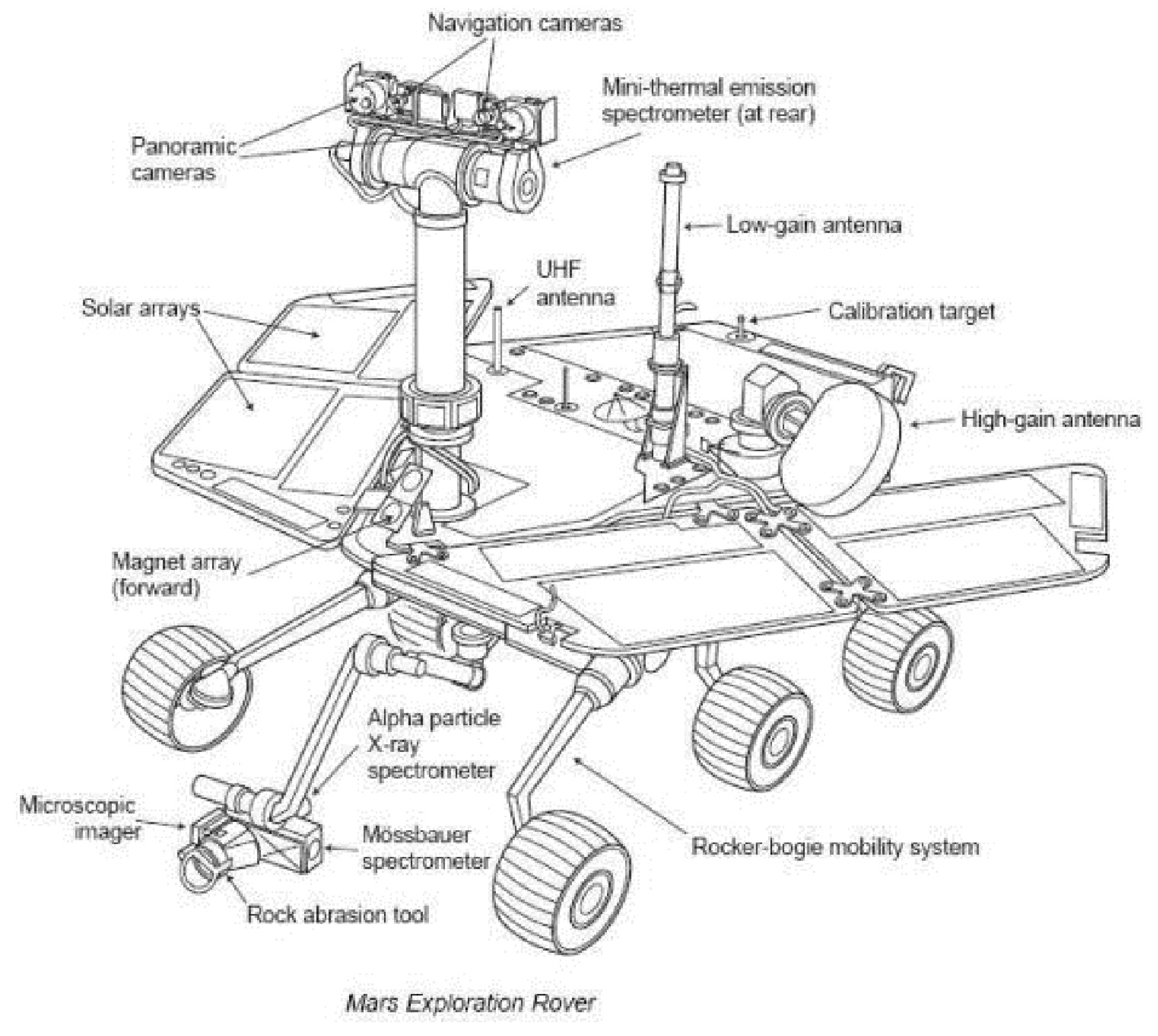

 The red star marks the landing site of the Opportunity rover.
The red star marks the landing site of the Opportunity rover.
 The red star marks the landing site of the Opportunity rover.
The red star marks the landing site of the Opportunity rover.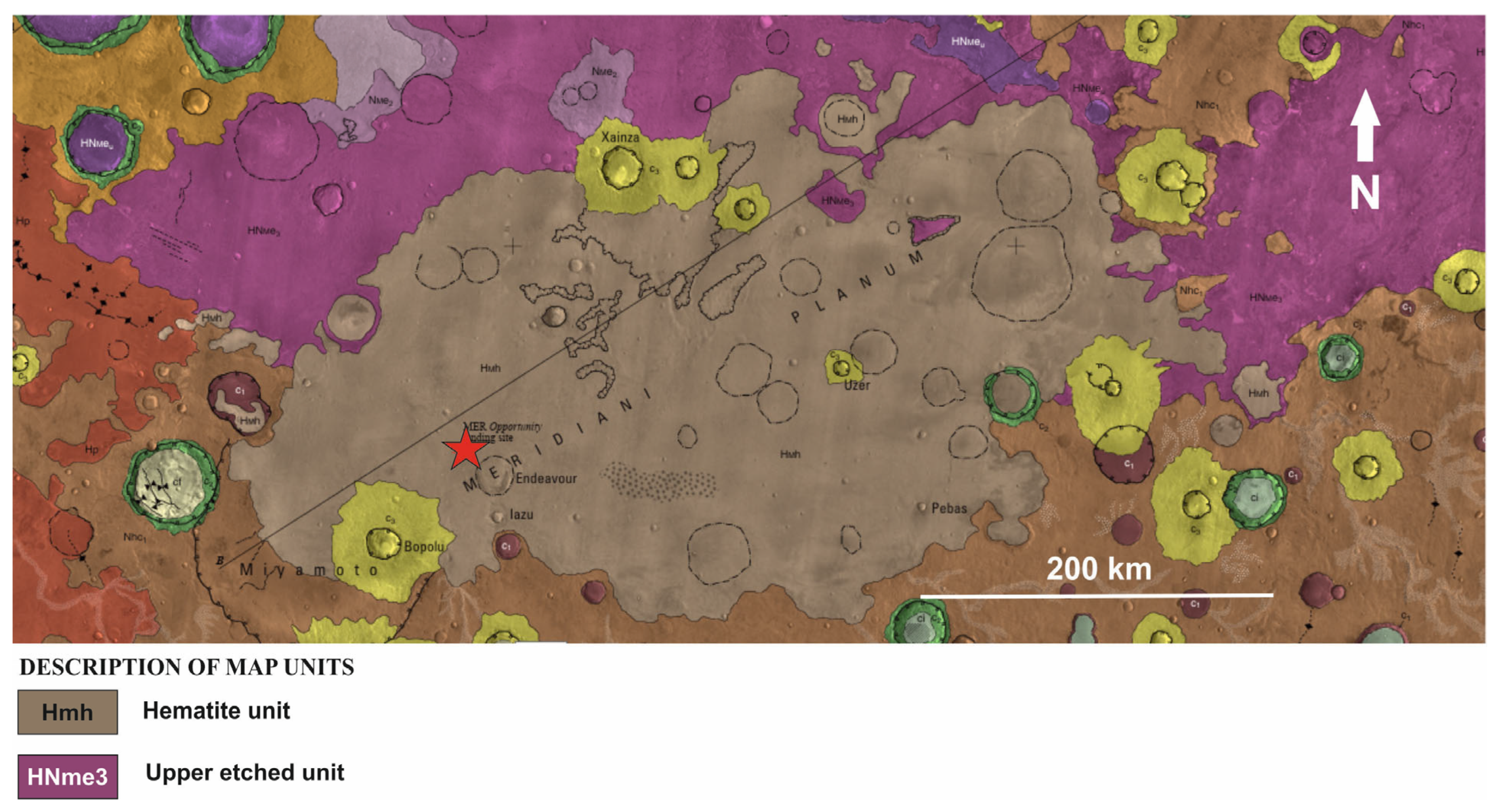
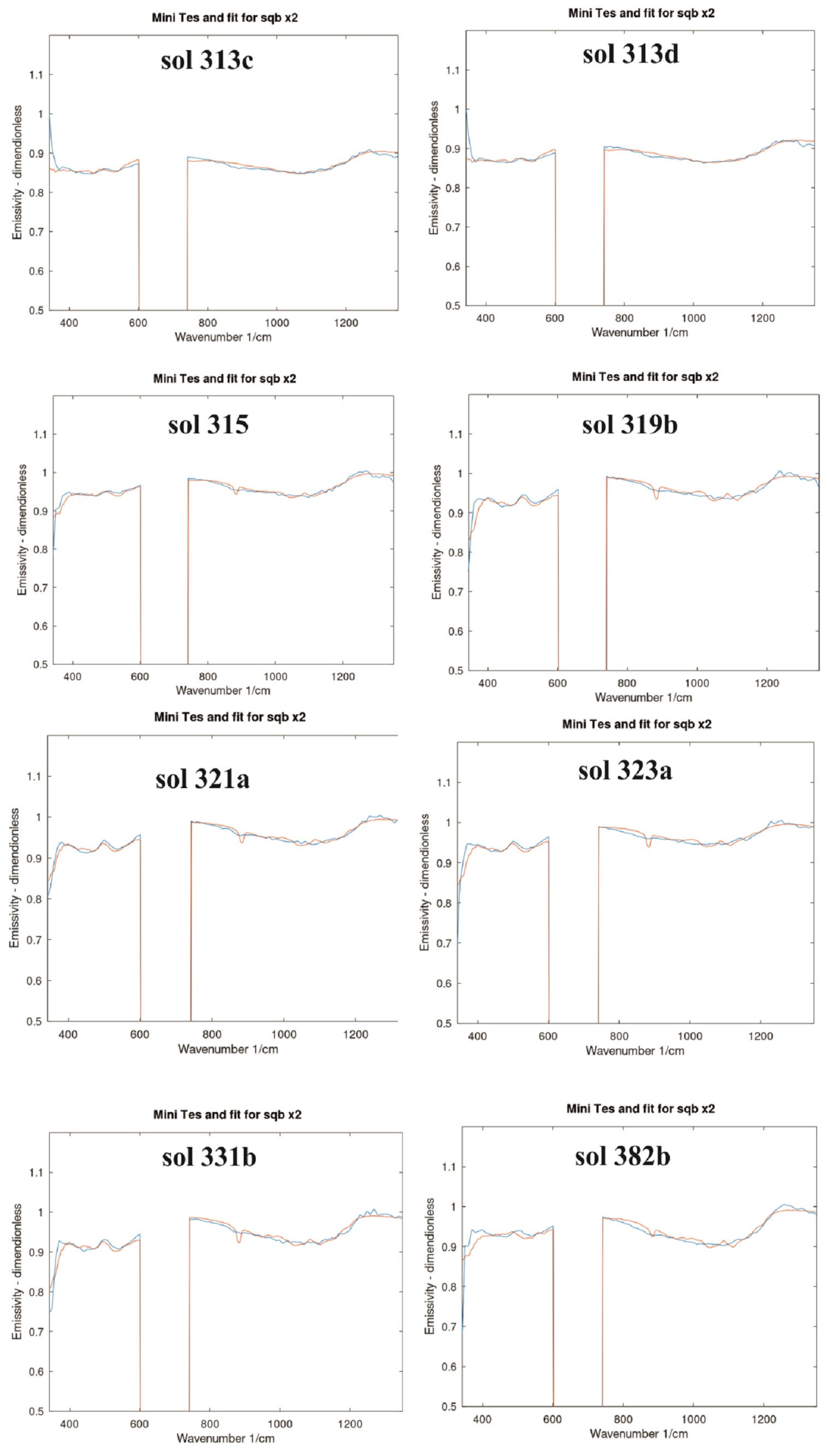
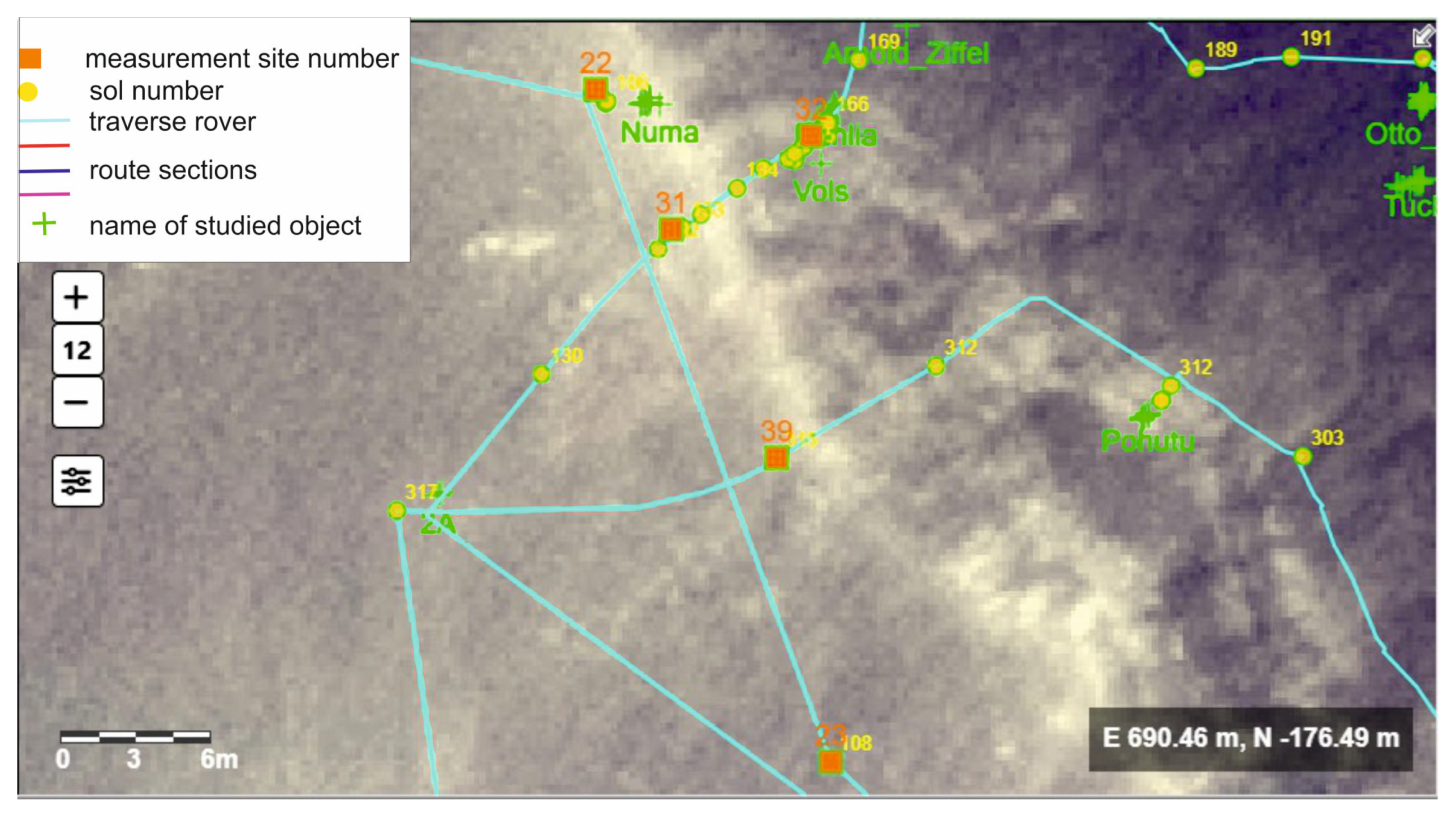



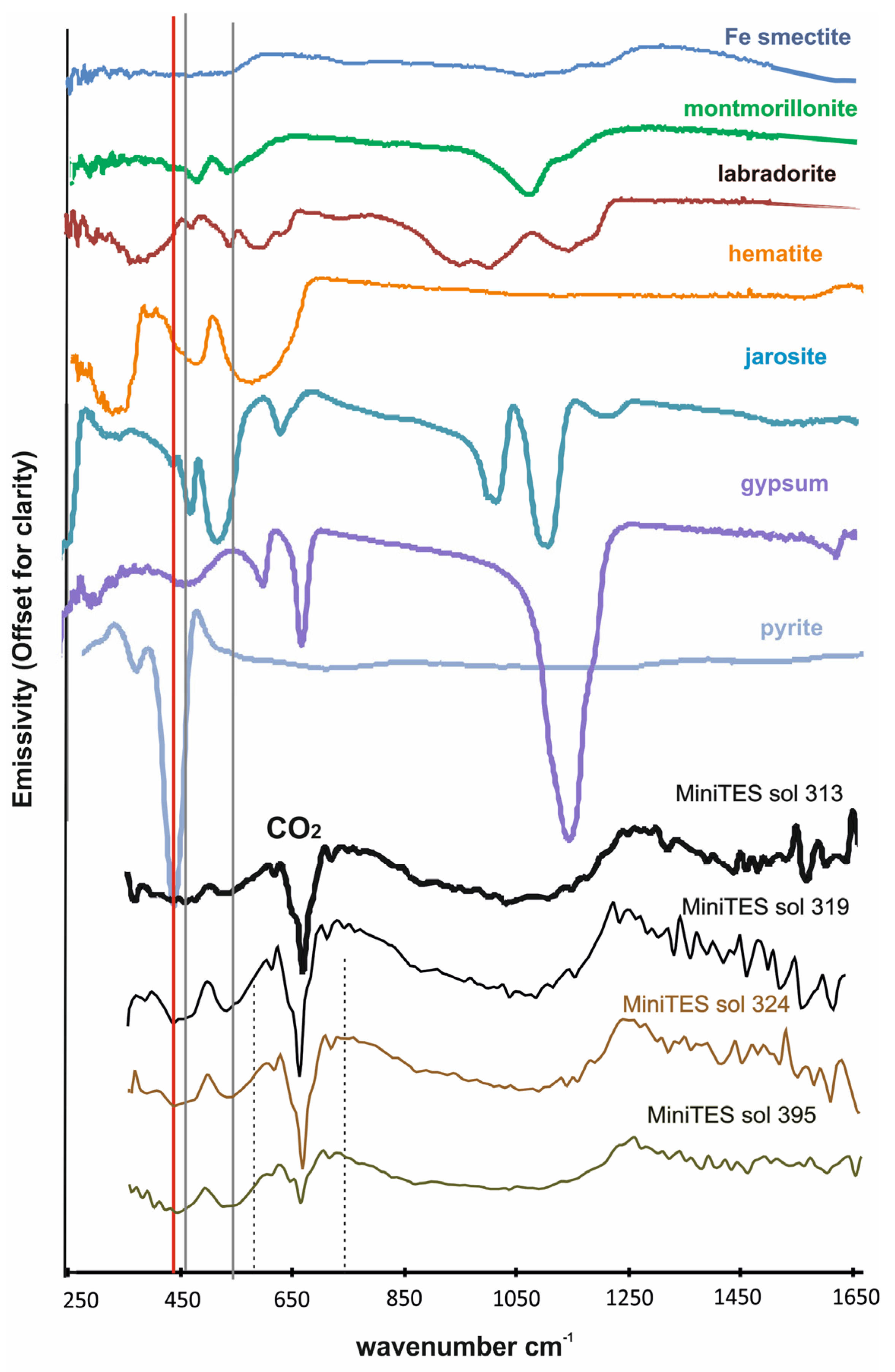
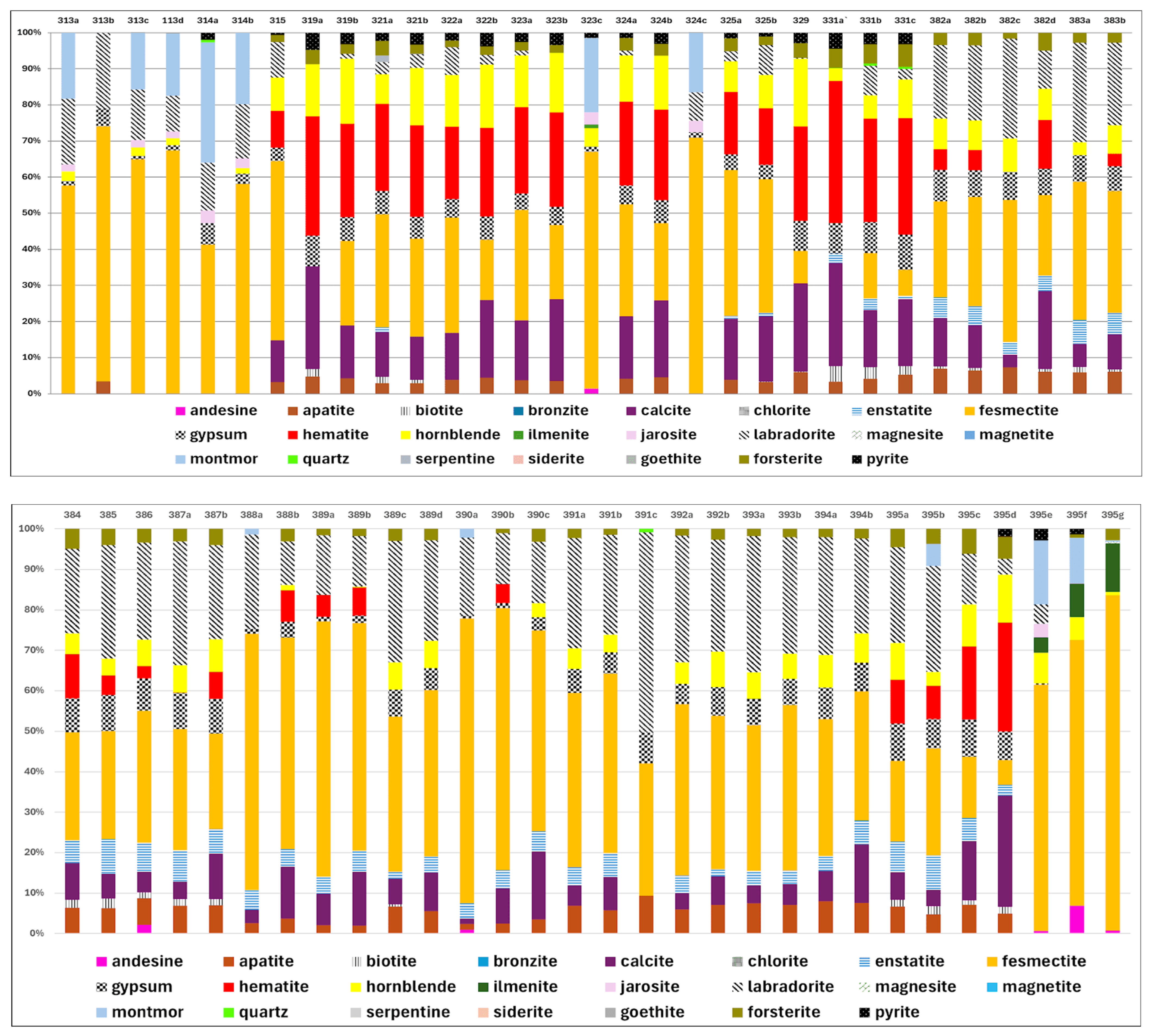
| Property | Value/Remarks |
|---|---|
| Mass | 2.40 kg |
| Size | 23.5 cm × 16.3 cm × 15.5 cm |
| Power consumption | 5.6 W (average) |
| Wavelength range | 5–29 µm (in infrared) |
| Wavenumber range | 339.50 to 1997.06 cm−1 |
| Sample interval | 9.99 cm−1. |
| Resolution (angular) | 20 mrad (it could be reduced to 8 mrad) |
| Radiometric precision or range between 450 and 1500 cm−1 for >270 K | +/−1.8 × 10−8 W cm−2 sr−1/cm−1 |
| Radiometric precision for shorter (300 cm−1) and longer (1800 cm−1) waves | ~4.2 × 10−8 W cm−2 sr−1/cm−1 |
| Absolute radiance error | less than 5 × 10−8 Watt cm−2 sr−1/cm−1 |
| Developed by | Arizona State University and Raytheon Santa Barbara Remote Sensing (SBRS) |
| Our Notation | Notation in PDS Planetary Data System https://pds-geosciences.wustl.edu/mer/mer1-m-mtes-4-emr-v1/mer1mt_3xxx/data/ (accessed on 29 April 2025) | Our Notation | Continuation of the Left Column Notation in PDS Planetary Data System https://pds-geosciences.wustl.edu/mer/mer1-m-mtes-4-emr-v1/mer1mt_3xxx/data/ (accessed on 29 April 2025) |
|---|---|---|---|
| 0313a | 1t155968073emr38h7p3576n0a1 | 0384 | 1t162271126emr4403p3575n0a1 |
| 0313b | 1t155970233emr38h7p3290n0a1 | 0385 | 1t162359900emr4503p3575n0a1 |
| 0313c | 1t155971234emr38h7p3575n0a1. | 0386 | 1t162448685emr4603p3575n0a1 |
| 0313d | 1t155971951emr38h7p3575n0a1 | 0387a | 1t162535829emr4603p3575n0a1 |
| 0314a | 1t156055646emr38h7p3575n0a1 | 0387b | 1t162537464emr4603p3575n0a1 |
| 0314b | 1t156056856emr38h7p3575n0a1 | 0388a | 1t162624808emr4700p3575n0a1 |
| 0315 | 1t156144440emr38h7p3575n0a1 | 0388b | 1t162626234emr4700p3575n0a1 |
| 0319a | 1t156500733emr3940p3575n0a1 | 0389a | 1t162713380emr4700p3575n0a1 |
| 0319b | 1t156499520emr3940p3575n0a1 | 0389b | 1t162715024emr4700p3575n0a1 |
| 0321a | 1t156677094emr3981p3575n0a1 | 0389c | 1t162716469emr4700p3972n0a1 |
| 0321b | 1t156678275emr3981p3575n0a1 | 0389d | 1t162716917emr4700p3973n0a1 |
| 0322a | 1t156765845emr4000p3575n0a1 | 0390a | 1t162802322emr4700p3575n0a1 |
| 0322b | 1t156767047emr4000p3575n0a1 | 0390b | 1t162803779emr4700p3575n0a1 |
| 0323a | 1t156859422emr4000p3575n0a1 | 0390c | 1t162808419emr4700p3976n0a1 |
| 0323b | 1t156860754emr4000p3575n0a1 | 0391a | 1t162891150emr4705p3575n0a1 |
| 0323c | 1t156862377emr4000p3575n0a1 | 0391b | 1t162892555emr4705p3575n0a1 |
| 0324a | 1t156943733emr4000p3575n0a1 | 0391c | 1t162893249emr4705p3290n0a1 |
| 0324b | 1t156944602emr4000p3575n0a1 | 0392a | 1t162979928emr4705p3575n0a1 |
| 0324c | 1t156950645emr4075p3715n0a1 | 0392b | 1t162984295emr4705p3977n0a1 |
| 0325a | 1t157032170emr4075p3575n0a1 | 0393a | 1t163068603emr4705p3575n0a1 |
| 0325b | 1t157033393emr4075p3575n0a1 | 0393b | 1t163070132emr4705p3575n0a1 |
| 0329 | 1t157388477emr40a3p3575n0a1 | 0394a | 1t163157489emr4705p3575n0a1 |
| 0331a | 1t157570782emr40ajp3575n0a1 | 0394b | 1t163158927emr4705p3575n0a1 |
| 0331b | 1t157565012emr40ajp3575n0a1 | 0395a | 1t163245881emr4786p3575n0a1 |
| 0331c | 1t157566061emr40ajp3575n0a1 | 0395b | 1t163246388emr4786p3575n0a1 |
| 0382a | 1t162093577emr4336p3575n0a1 | 0395c | 1t163247648emr4786p3575n0a1 |
| 0382b | 1t162094557emr4336p3575n0a1 | 0395d | 1t163252492emr4786p3575n0a1 |
| 0382c | 1t162095419emr4336p3715n0a1 | 0395e | 1t163254368emr4786p3575n0a1 |
| 0382d | 1t162098649emr4336p3575n0a1 | 0395f | 1t163255320emr4786p3575n0a1 |
| 0383a | 1t162181197emr4336p3575n0a1 | 0395g | 1t163256838emr4786p3575n0a1 |
| 0383b | 1t162182367emr4336p3575n0a1 |
| Name of File in Librabry ASU Spectral Library https://speclib.asu.edu/ (accessed on 29 April 2025) | Name in Our Paper and Remarks |
|---|---|
| Andesine BUR-240 1 | andesine |
| Apatite ML-P1 86 | apatite |
| Biotite BUR-840 25 | biotite |
| Bronzite BUR-1920 6 | bronzite |
| Calcite ML-C9 98 | calcite |
| Chlorite WAR-1924 40 | chlorite |
| Enstatite HS-9.4B 30 | enstatite |
| Fe–smectite SWa-1 powder 205 | fe–smectite |
| Gypsum (Selenite) ML-S8 83 | gypsum |
| Hematite BUR-2600 50 | hematite |
| Hornblende NMNH-R7208 173 | hornblende |
| Ilmenite WAR-4119 35 | ilmenite |
| Jarosite S51 | jarosite |
| Labradorite WAR-4524 63 | labradorite |
| Magnesite C55 132 | magnesite |
| Magnetite WAR-0384 64 | magnetite |
| Montmorillonite SCa-3 powder 198 | montmorillonite |
| Quartz BUR-4120 55 | quartz |
| Serpentine HS-8.4B 14 | serpentine |
| Siderite130 Siderite C50 130 | siderite |
| Goethite ASU | goethite |
| Forsterite038 | forsterite |
| Emiss_pyrite_waven DLR | pyrite (see table caption) |
| Range of Sectors Numbers of Measurements Sector No. | 313-314b 6 1 | 315-331c 19 2 | 382a-389b 15 3 | 389c-394a 14 4 | 395a-395d 4 5 | 395e-395g 3 6 |
|---|---|---|---|---|---|---|
| andesine | 1% | 0% | 0% | 0% | 0% | 6% |
| apatite | 1% | 3% | 5% | 6% | 5% | 0% |
| biotite | 0% | 1% | 1% | 0% | 2% | 0% |
| bronzite | 0% | 0% | 0% | 0% | 0% | 0% |
| calcite | 0% | 15% | 7% | 5% | 11% | 0% |
| chlorite | 0% | 0% | 0% | 0% | 0% | 0% |
| enstatite | 0% | 1% | 6% | 3% | 7% | 0% |
| fe–smectite | 60% | 31% | 41% | 46% | 21% | 68% |
| gypsum | 3% | 5% | 6% | 5% | 8% | 0% |
| hematite | 0% | 21% | 3% | 0% | 13% | 0% |
| hornblende | 2% | 11% | 4% | 4% | 5% | 4% |
| ilmenite | 0% | 0% | 0% | 0% | 0% | 9% |
| jarosite | 2% | 0% | 0% | 0% | 0% | 1% |
| labradorite | 15% | 4% | 23% | 29% | 19% | 0% |
| magnesite | 0% | 0% | 0% | 0% | 0% | 0% |
| magnetite | 0% | 0% | 0% | 0% | 0% | 0% |
| montmorillonite | 17% | 2% | 0% | 0% | 4% | 9% |
| quartz | 0% | 0% | 0% | 0% | 0% | 0% |
| serpentine | 0% | 0% | 0% | 0% | 0% | 0% |
| siderite | 0% | 0% | 0% | 0% | 0% | 0% |
| goethite | 0% | 0% | 0% | 0% | 0% | 0% |
| forsterite | 0% | 3% | 3% | 2% | 4% | 1% |
| pyrite | 0% | 2% | 0% | 0% | 0% | 1% |
| SUM | 100% | 100% | 100% | 100% | 100% | 100% |
| 392a | 392b | 393a | 393b | 394a | 394b | 395e | |
|---|---|---|---|---|---|---|---|
| andesine | 0% | 0% | 0% | 0% | 0% | 0% | 9% |
| apatite | 6% | 7% | 7% | 7% | 8% | 7% | 0% |
| biotite | 0% | 0% | 0% | 0% | 0% | 0% | 0% |
| bronzite | 0% | 0% | 0% | 0% | 0% | 0% | 0% |
| calcite | 3% | 5% | 3% | 3% | 5% | 11% | 0% |
| chlorite | 0% | 0% | 0% | 0% | 0% | 0% | 0% |
| enstatite | 4% | 1% | 3% | 3% | 3% | 5% | 0% |
| fe–smectite | 44% | 41% | 38% | 44% | 37% | 36% | 59% |
| gypsum | 5% | 7% | 6% | 6% | 7% | 6% | 0% |
| hematite | 0% | 0% | 0% | 0% | 0% | 0% | 0% |
| hornblende | 5% | 8% | 6% | 6% | 7% | 6% | 7% |
| ilmenite | 0% | 0% | 0% | 0% | 0% | 0% | 5% |
| jarosite | 0% | 0% | 0% | 0% | 0% | 0% | 3% |
| labradorite | 32% | 30% | 35% | 31% | 32% | 27% | 0% |
| magnesite | 0% | 0% | 0% | 0% | 0% | 0% | 0% |
| magnetite | 0% | 0% | 0% | 0% | 0% | 0% | 0% |
| montmor | 0% | 0% | 0% | 0% | 0% | 0% | 15% |
| quartz | 0% | 0% | 0% | 0% | 0% | 0% | 0% |
| serpentine | 0% | 0% | 0% | 0% | 0% | 0% | 0% |
| siderite | 0% | 0% | 0% | 0% | 0% | 0% | 0% |
| goethite | 0% | 0% | 0% | 0% | 0% | 0% | 0% |
| forsterite | 2% | 3% | 2% | 2% | 2% | 2% | 1% |
| pyrite | 0% | 0% | 0% | 0% | 0% | 0% | 2% |
| Sector | 4 | 4 | 4 | 4 | 4 | 4 | 6 |
Disclaimer/Publisher’s Note: The statements, opinions and data contained in all publications are solely those of the individual author(s) and contributor(s) and not of MDPI and/or the editor(s). MDPI and/or the editor(s) disclaim responsibility for any injury to people or property resulting from any ideas, methods, instructions or products referred to in the content. |
© 2025 by the authors. Licensee MDPI, Basel, Switzerland. This article is an open access article distributed under the terms and conditions of the Creative Commons Attribution (CC BY) license (https://creativecommons.org/licenses/by/4.0/).
Share and Cite
Natalia, Z.; Czechowski, L. Meridiani Planum Mineralogy Along Part of the Opportunity Rover Track Based on the Mini-TES Spectrum. Remote Sens. 2025, 17, 1981. https://doi.org/10.3390/rs17121981
Natalia Z, Czechowski L. Meridiani Planum Mineralogy Along Part of the Opportunity Rover Track Based on the Mini-TES Spectrum. Remote Sensing. 2025; 17(12):1981. https://doi.org/10.3390/rs17121981
Chicago/Turabian StyleNatalia, Zalewska, and Leszek Czechowski. 2025. "Meridiani Planum Mineralogy Along Part of the Opportunity Rover Track Based on the Mini-TES Spectrum" Remote Sensing 17, no. 12: 1981. https://doi.org/10.3390/rs17121981
APA StyleNatalia, Z., & Czechowski, L. (2025). Meridiani Planum Mineralogy Along Part of the Opportunity Rover Track Based on the Mini-TES Spectrum. Remote Sensing, 17(12), 1981. https://doi.org/10.3390/rs17121981





